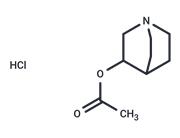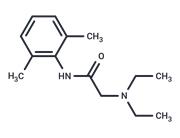| Name | Lidocaine hydrochloride |
| Description | Lidocaine hydrochloride (Lignocaine hydrochloride) is a local anesthetic and cardiac depressant used as an antiarrhythmic agent. Its actions are more intense and its effects more prolonged than those of PROCAINE but its duration of action is shorter than that of BUPIVACAINE or PRILOCAINE. |
| Cell Research | Cells at logarithmic phase are treated with lidocaine hydrochloride at concentrations (w/v) from 10 to 0.15625 g/l in step dilutions. HCE cells without lidocaine treatment are used as controls. The morphology and growing status of the cells are monitored every 4 hr.(Only for Reference) |
| In vitro | Lidocaine above 1.25 g/l reduces cellular viability and triggers apoptosis in HCE cells in a time- and dose-dependent manner. Lidocaine-induced apoptosis is caspase dependent and may be related to mitochondrial pathway[1]. Lidocaine, at the level of tissue concentration under topical or local administration, also has a direct inhibitory effect on the activity of epidermal growth factor receptor (EGFR), which is a potential target for antiproliferation in cancer cells[3]. |
| In vivo | Intravenous administration of the local anaesthetic lidocaine has been used to treat neuropathic pain for several decades and significantly improves postoperative pain associated with complex spine surgery and cholecystectomy. It is well established that lidocaine used for regional anaesthesia blocks impulses in peripheral nerves by inhibiting voltage-gated sodium (Na+) channels. Intravenous lidocaine has an analgesic effect on mechanical noxious response, decreases the spinal noxious response induced by peripheral pinch stimuli and the frequency of spontaneous excitatory postsynaptic currents(EPSCs) without changing their amplitude. It has no effect on spontaneous inhibitory postsynaptic currents and produces an outward current in SG neurons[2]. |
| Storage | Powder: -20°C for 3 years | In solvent: -80°C for 1 year | Shipping with blue ice/Shipping at ambient temperature. |
| Solubility Information | H2O : 50 mg/mL (184.64 mM), Sonication is recommended.
DMSO : 50 mg/mL (184.64 mM), Sonication is recommended.
10% DMSO+40% PEG300+5% Tween 80+45% Saline : 2 mg/mL (7.39 mM), Sonication is recommended.
Ethanol : 54 mg/mL (199.41 mM), Sonication is recommended.
|
| Keywords | SodiumChannel | Sodium Channel | Nuclear factor-κB | Nuclear factor-kappaB | NF-κB | NFκB | NF-kB | NFkB | Na+ channels | Na channels | Mitogen-activated protein kinase kinase | MEK | MAPKK | MAP2K | Lignocaine Hydrochloride | Lignocaine | Lidocaine hydrochloride | Lidocaine Hydrochloride | Lidocaine | Inhibitor | inhibit | Extracellular signal regulated kinases | ERK | Apoptosis |
| Inhibitors Related | Stavudine | Cysteamine hydrochloride | Phenytoin sodium | Sodium 4-phenylbutyrate | L-Ascorbic acid | L-Glutamic acid | Tributyrin | Valproic Acid | N,N-Dimethylacetamide | L-Ascorbic acid sodium salt | Alginic acid | Dextran sulfate sodium salt (MW 5000) |
| Related Compound Libraries | Bioactive Compound Library | Membrane Protein-targeted Compound Library | Anti-Cancer Clinical Compound Library | Drug Repurposing Compound Library | Neuroprotective Compound Library | Inhibitor Library | Anti-Cancer Approved Drug Library | FDA-Approved Kinase Inhibitor Library | FDA-Approved Drug Library | Bioactive Compounds Library Max | Ion Channel Targeted Library | Anti-Cancer Drug Library |

 United States
United States






